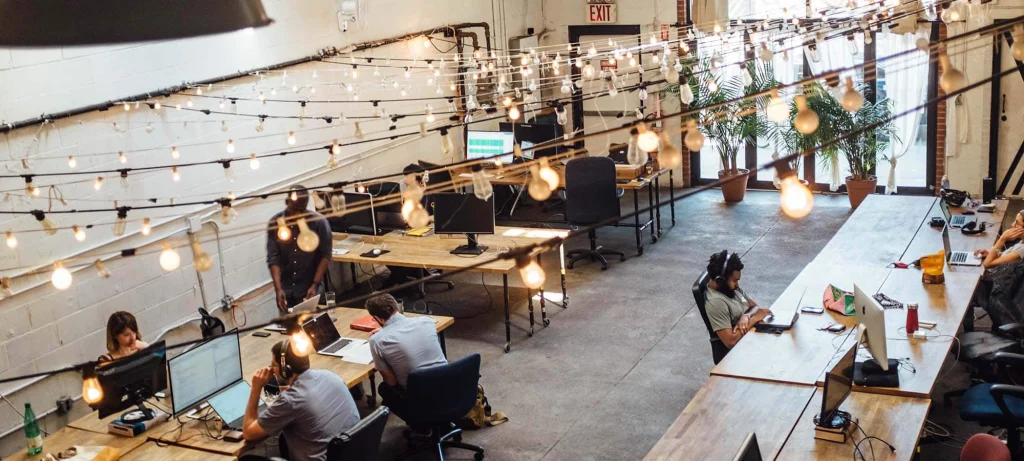
Over the past few years, businesses have started to question whether open offices really encourage the behaviors they’re supposed to inspire. But that might well be the wrong starting point for this discussion, as Gerry Brennan explains.
Get a free demo
Enquire about a no-obligation demo today and get an exclusive hybrid working research paper — for free. Created in partnership with YouGov, this invaluable guide provides essential insights into developing your own effective hybrid strategy. Click below.
Office design and the importance of employee empowerment
Open offices were introduced with the aim of encouraging sociability and cooperation, but in the past decade, we’ve seen many studies that suggest the opposite.
Research from Harvard University this year looked at 100,000 workplace conversations and found that face-to-face interaction in open office spaces decreased by 70%, whilst IM activity grew by 67% – people are talking less and typing more. Open offices might have made the office more sociable once, but with the introduction of modern comms and collaborative technology, actually talking to your co-workers simply isn’t necessary.
Despite these studies, this isn’t the case for everyone. The University of Queensland provides a good counter-example, finding in 2016 that open office environments actually helped engineering teams collaborate on process improvements and suited teams that needed to respond quickly to change. Tech being a barrier to in-person interaction is a problem that businesses need to consider, but it doesn’t affect every employee.
Wherever you stand on it, this debate risks missing out on providing what employees need to work well. Businesses are assuming that changing the layout of the office will change employees in a positive way, when they should be shaping an environment around their routines and preferences.
Effective employee empowerment
Rather than providing a one-size-fits-all solution, employers should be focusing on employee empowerment on an individual bacis. Businesses that give employees a say in where, when and how they work are offering an opportunity to reduce stress and improve productivity. It also makes employees feel valued as an individual, boosting morale and staff retention.
So what questions should employers be asking themselves when it comes to empowering the employee?
1 Where does the employee want to work?
The modern workforce is as connected as it has ever been. Work emails follow us home and mobile data is widely available, speeding up as 5G rolls out. Often, we find ourselves taking work home even when we don’t want to! The office was once necessary to provide tools and connectivity for the working day, but that’s no longer the case.
The solution is simple: forget the need for a permanent office space and give employees the choice to work flexibly. The Office for National Statistics found earlier this year that 91% of employees would be more productive and motivated if they could choose their work environment. Freeing employees from the obligation of office work empowers them to make the choices that benefit their daily lives.
While many will embrace flexible working, other employees will actively enjoy coming into the office every day, and employers need to cater to them too. Flexible working spaces that let employees choose when and where they work within the office can give them control over the simple aspects of work life that make or break their day, just as freeing employees from the office can liberate them.
2 What tools do employees have at their disposal?
Once the employee can choose where they work, it’s crucial to provide a toolkit that lets them work effectively wherever they are. Businesses need to identify the high-quality utilities that make the transition from the workplace to elsewhere as frictionless as possible.
Robust IM and email clients keep employees connected to contacts and their teams on the move or in the office thanks to the reach and quality of mobile data, while cloud storage provides access to all the files and information that the office would normally provide. If businesses can give their employees the right range of tools, they’re capable of allowing the employee to take the office with them wherever they go.
This freedom can also be achieved without compromising on security. The cloud is well-known to be as secure as any in-office network thanks to comprehensive security measures and can be accessed through a data connection that doesn’t have the vulnerabilities of office Wi-Fi. It’s arguable that data is actually less secure within an office environment than outside it, depending on how it’s accessed and stored.
3 How does the workplace actually work?
While employees shouldn’t be shackled to the office, it’s equally important that they have a positive experience when they are onsite. The office environment can make or break the working day as employees go through everyday processes like organising workspaces and meetings, or even something as simple as where they choose to sit for the day.
To guarantee a good experience, employees need to have control over their space. Collaborative spaces and meeting facilities should be easy to organise, both remotely and onsite. Hotdesking solutions should be similarly accessible, giving employees the option to change their workspace depending on how they feel that day.
This flexibility is important in two ways: not only should an employee be able to exercise control over their workspace easily, but it also gives them the opportunity to personalise their work environment. Being able to change the space around you to accommodate for things like mood, weather and co-workers in the office empowers an employee, valuing them as an individual and trusting them to make their own decisions.
Summing up
The thought process here is not radical; employees want to be happy at work, and happy workers work harder. A little bravery and a little faith in employees as individuals, and a shift from focusing on the work environment to the people within it could be all it takes to empower employees. The reward for that is a happier and harder working workforce contributing more back to the business.
Gerry Brennan is CEO at smart workplace company Cloudbooking.


